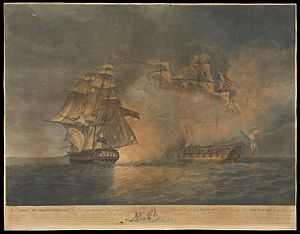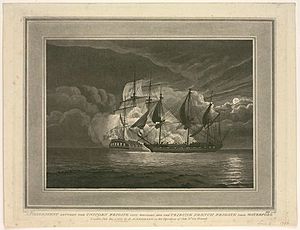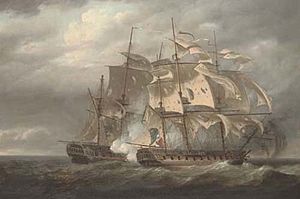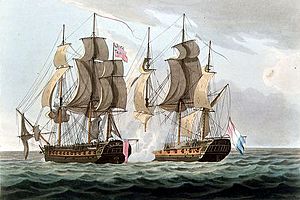Atlantic raid of June 1796 facts for kids
Quick facts for kids Atlantic raid of June 1796 |
|||||||
|---|---|---|---|---|---|---|---|
| Part of the French Revolutionary Wars | |||||||
 Capture of the French Frigate La Tribune by His Majesty's Ship The Unicorn on the 8th June 1796, Nicholas Pocock |
|||||||
|
|||||||
| Belligerents | |||||||
| Commanders and leaders | |||||||
| Strength | |||||||
| 3 frigates | 3 frigates 1 corvette |
||||||
| Casualties and losses | |||||||
| 4 killed 10 wounded |
99 killed 79 wounded 3 frigates captured 1 corvette captured |
||||||
The Atlantic raid of June 1796 was a series of naval battles. These fights happened in the Atlantic Ocean during the French Revolutionary Wars. The Royal Navy (Britain's navy) wanted to stop French warships. These French ships were attacking British merchant ships.
Even though Britain's navy was strong, French ships called "commerce raiders" were causing problems. They would go on short trips to attack British trade ships. So, British frigate squadrons, groups of fast warships, patrolled the seas. They often sailed from Cork, Ireland, looking for these French raiders.
One such British group included two 36-gun frigates: HMS Unicorn and HMS Santa Margarita. They were near the Scilly Isles when they spotted a French squadron. This French group had two frigates, Tribune and Tamise, plus a smaller ship called a corvette, Légėre.
The two sides were about the same size. But the French ships had orders to attack trade, not fight British warships. So, they tried to escape. The British frigates chased them closely. Over the day, they slowly caught up.
At 4:00 PM, Santa Margarita reached Tamise. A fierce battle began. The smaller Tamise was badly damaged and had to surrender. Tribune kept trying to get away. But Unicorn finally caught her at 10:30 PM. Unicorn won a second tough fight. Légėre didn't join the battles and managed to escape.
Five days later, another French frigate, Proserpine, was looking for her friends. She had left Brest and was off Cape Clear in Southern Ireland. A British frigate, HMS Dryad, found her. Dryad chased Proserpine down and forced her to surrender after a 45-minute fight.
Nine days later, Légėre was captured without a fight by another British patrol. The French suffered many casualties (killed or wounded) in all three battles. British losses were very low. After these victories, all four captured French ships were bought by the Royal Navy. They were then used as British warships.
Contents
Why These Battles Happened
The French Revolutionary Wars started in 1793. For the first three years, the French navy faced many problems. Their main fleet was based at Brest. In 1794, seven French battleships were lost at the Glorious First of June battle. The next year, five more were wrecked in winter storms. In June 1795, three more were captured at the Battle of Groix.
With their main fleet weakened, the French navy changed its plan. They decided to attack British trade ships instead. Most of these trade ships sailed through the Western Approaches and the English Channel. French privateers (private ships allowed to attack enemy shipping) and small groups of frigates carried out these attacks. They sailed from Brest and other French ports.
These French attacks on British trade were somewhat successful. To fight back, the Royal Navy formed squadrons of fast frigates. These groups patrolled the Channel and the Bay of Biscay. They were looking for the French warships. This led to several battles between British and French frigate squadrons.
The southern coast of Ireland was a risky area. It was close to trade routes and had many hidden places for French ships to hide. To protect this area, a Royal Navy frigate squadron was based in Cork. These ships patrolled the Channel, alone or in pairs, searching for French raiders.
On June 4, 1796, a French squadron left Brest to raid British trade. This group included the 40-gun frigates Tribune (led by Commodore Jean Moulston), Proserpine, and Tamise. Tamise was actually a former British ship, HMS Thames, captured by the French in 1793. The 18-gun corvette Légėre was also with them. Tamise had been very good at capturing merchant ships. Proserpine got separated from the others on June 7 due to heavy fog. She sailed alone to the meeting point off Cape Clear.
Battles of Tamise and Tribune

On June 8, at 2:00 AM, the French ships were sailing southeast of the Scilly Isles. They saw sails about 3 miles away. These were the British frigates HMS Unicorn (Captain Thomas Williams) and HMS Santa Margarita (Captain Thomas Byam Martin). These ships were part of the Cork squadron, sent to find French raiders.
The British frigates had just captured a Swedish merchant ship. It was carrying illegal Dutch goods. They sent it to Cork and immediately went after the French ships. The French turned away, sailing in a line. Tribune was faster and led the line, waiting for the others. But as the British ships got closer, Légėre fell behind. Both British frigates passed the corvette. Légėre then left to attack a nearby merchant ship.
By 1:00 PM, the British frigates were close enough for Tamise and Tribune to fire their stern-chasers (guns at the back of the ship). These shots damaged the British ships' sails and ropes, making them slow down. This gave the French ships three hours. But by 4:00 PM, it was clear that Santa Margarita would catch the slower Tamise. Captain Williams had told Martin to focus on Tamise, as he planned to attack the larger Tribune himself.
To avoid Santa Margarita and hopefully damage her, Tamise's captain, Fradin, turned his ship. He tried to cross in front of Santa Margarita to fire along her length (a "raking fire"). But Captain Martin quickly brought Santa Margarita alongside Tamise. The two ships fought fiercely, firing their main guns (broadsides) for 20 minutes. Tamise was badly damaged, and her crew suffered many casualties. Fradin was forced to surrender.

While Tamise and Santa Margarita fought, Unicorn continued chasing Tribune. Without Tamise to slow her down, Tribune could sail faster. She pulled ahead of Unicorn during the afternoon. Tribunes stern-chasers kept damaging Unicorns ropes and sails. At one point, they shot away a main sail. It was only when night fell and the wind died down that Williams could catch up. He used special sails called "studding sails."
At 10:30 PM, after a chase of 210 miles, Unicorn finally got alongside Tribune. For 35 minutes, the frigates fired at each other from close range. Under the cover of smoke, Moulston tried to escape. He pulled Tribune back and turned across Unicorn's stern, hoping to rake the British ship. But Williams quickly turned Unicorn in reverse. As the British ship sailed backward, it crossed Tribunes bow. This allowed Unicorn to fire along Tribunes length, causing huge damage. From this position, Unicorns fire knocked down Tribunes front and main masts. Her smaller rear mast was also shot away. This made the French ship unable to move. With no hope of escape and many crew members killed or wounded, the injured Moulston surrendered to Williams.
The battles were quite even. Tamise and Santa Margarita fired similar amounts of cannonball weight. Tamise had more crew, but Santa Margarita was larger. In the second battle, Tribune had more crew and was larger than Unicorn. But Unicorn had heavier guns, which fired more cannonball weight. This was the key to her victory. Both battles had similar casualty numbers. Tamise lost 32 killed and 19 wounded. Tribune lost 37 killed and 15 wounded. On the British side, Santa Margarita had two killed and three wounded. Unicorn had no casualties at all.
The Fight with Proserpine
While Tamise and Tribune were fighting, Proserpine had continued sailing alone. She was off the Cork coast. On June 13, at 1:00 AM, Proserpine's crew saw a sail approaching. Captain Pevrieux was looking for Moulston's squadron. He let his ship get closer. But he soon realized it was the British frigate HMS Dryad (Captain Lord Amelius Beauclerk).
Realizing the danger, Pevrieux turned Proserpine away and tried to escape. The chase lasted most of the day. Beauclerk slowly gained on Proserpine. At 8:00 PM, Pevrieux started firing his stern-chasers.
The shots from Proserpine's stern-chasers made holes in Dryads sails and damaged her ropes. But Dryad kept gaining. At 9:00 PM, Beauclerk was close enough to fire his main guns. Dryads sails and ropes were slightly damaged, and her flag was shot away. But she had few casualties. On Proserpine, many crew members were killed or wounded. Even though her sails were mostly fine, the damage to her hull and the heavy losses made Pevrieux surrender at 9:45 PM.
Like the earlier battles, the French ship had a much larger crew. But the amount of cannonball weight fired and the size of the ships were more similar. Casualties were also very unequal. Dryad had two killed and seven wounded. Proserpine had 30 killed and 45 wounded.
What Happened Next
The last French ship from the squadron, Légėre, stayed at sea for nine more days. She captured six merchant ships. Then, she was found by the British frigates HMS Apollo and HMS Doris. Légėre was captured without a fight.
All the captured French ships were taken to Britain. The Royal Navy bought them. Tamise became HMS Thames again. Tribune kept her name. Proserpine became HMS Amelia (because there was already an HMS Proserpine in service). Légėre was renamed HMS Legere.
Captain Williams, as the senior British captain, was later made a knight. The first lieutenants on each British ship were promoted. More than 50 years later, in 1847, the Admiralty gave out a special medal, the Naval General Service Medal, to all British sailors who were still alive and had fought in these battles.
After these captures, there was little naval activity in the English Channel for the rest of the year. In December 1796, the main French fleet sailed from Brest. This was for a big operation called the Expédition d'Irlande, a planned invasion of Ireland. But like their winter campaign two years before, this ended in disaster. Twelve ships were wrecked or captured, and thousands of soldiers and sailors drowned. Not a single landing was successful.


